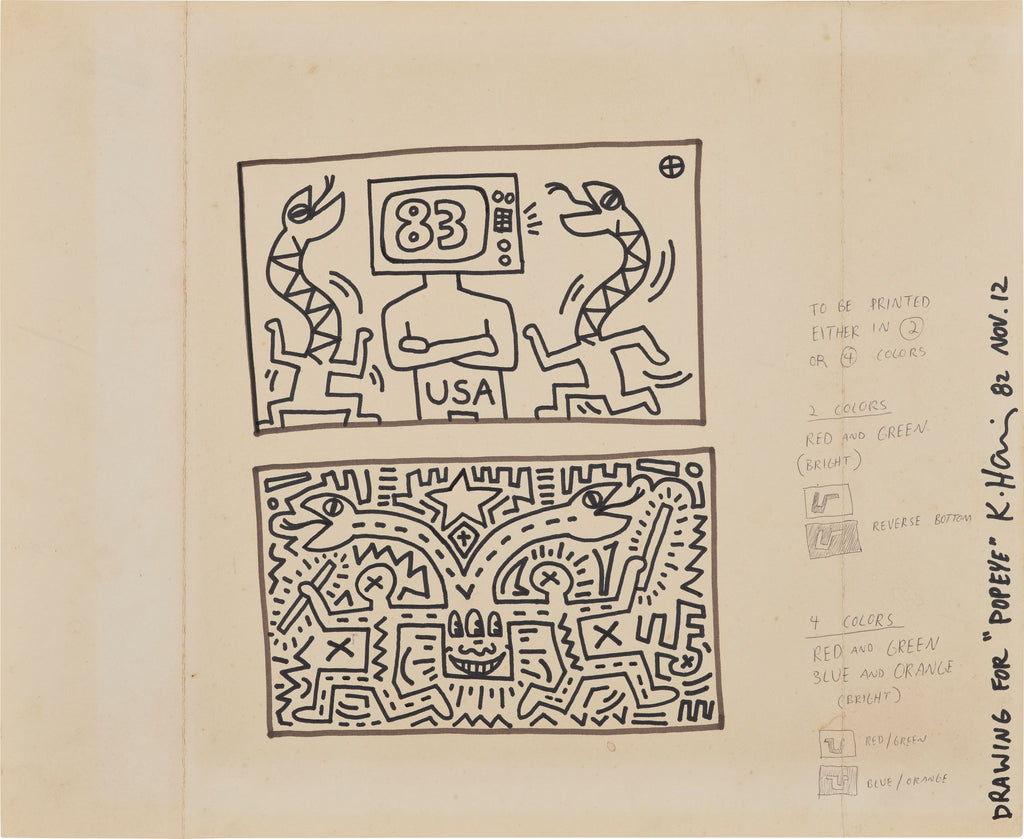Upload a photo of your space
For best results we recommend marking 10 inches on your wall with tape to get a sense of scale. Make sure to have the floor visible in the photo.






About the Work
"Untitled (Drawing for 'Popeye')" is a felt-tip pen and ink on paper drawing created by Keith Haring in 1982. The artwork is signed, titled and dated 'DRAWING FOR POPEYE' Keith Haring 82 Nov.12' right margin. The image size is 13.88 x 13.88" and the artwork is framed in a custom, ornate, gold-tone frame. The artwork ships framed.
It was rare for Haring to sketch and plan before creating his drawings, as his artistic process was famously spontaneous and intuitive. “Untitled (Drawing for ‘Popeye’)” stands out as an exceptionally rare preliminary print design, featuring pencil annotations from Haring on the right side of the main drawing which detail his color plans for both the top and bottom designs.
Created as a preparatory drawing for a print in 1983, this accompanied an article on Haring's artistic journey and life in New York as featured in the Japanese men's fashion magazine ‘Popeye’. The completed color version of the print was published along with the article in the January 10, 1983, edition of ‘Popeye’ - issue number 142, p.75. Popeye was among the very first Japanese magazine features to introduce Haring’s work comprehensively to a broad, style-conscious audience. The commentary positioned him as an artist whose work blurred the boundaries between fine art and pop culture — precisely the message that resonated with Popeye’s young readership. The article helped ignite Japanese interest in Haring’s work and aesthetic - anticipating the explosion of his influence on street fashion, magazines, and design culture in 1980s Japan.
Haring’s resonance with Japanese youth and culture has often been noted by Takashi Murakami in his lectures on the ‘Superflat’ movement, emphasizing how Haring’s flattened graphic language was in dialogue with Japanese manga. As Murakami would later explore himself, Haring collapsed the distance between fine art, street art, and product design. Murakami once said, “When I was in art school, I admired Keith Haring. He was one of the first artists I saw who was both in the museum and on the street, and who sold products in his Pop Shop. This made a big impression on me. It showed me that there is no boundary between art and merchandise.” (Grabner, Michelle. “Takashi Murakami: Interview.” Art in America, vol. 89, no. 6, June–July 2001, pp. 90–95.)
About the Artist
Keith Haring was a social activist and artist who wasn’t afraid to depict and publicize controversial topics such as war, sexuality, life, and death with his art. Haring used New York City - the walls, stations, and buildings - as his canvas, creating masterpieces for the public eye. His signature cartoon style combined his outspoken political and social activism place Haring amongst the legends in the art world. Born May 4, 1958, in Reading, Pennsylvania, Haring grew up fascinated by the cartoon art of Walt Disney, Charles Schultz, and even Dr. Seuss. Haring’s father also drew cartoons as a hobby in his free time, inspiring a young Haring to perhaps make his own one day. Eventually, as a grown man, he moved to New York City to enroll at the School of Visual Arts. It is there Haring found his artistic peers and social niche and became acquainted with Jean-Michel Basquiat and Kenny Scharf, among other individuals in the underground art scene.
Please utilize the AR experience in a well-lit room.
Scan the room for surface detection.

Artwork will place in your room.
Using your fingers, align the horizontal white line
with your floor.

Double tap the artwork to scale to 100% size
and pinch to move on the screen.









